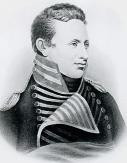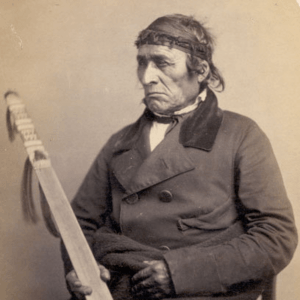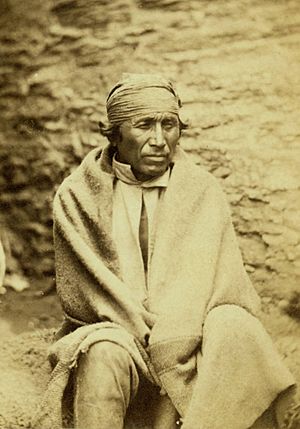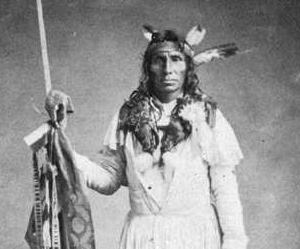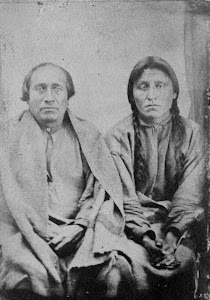Shakopee (Dakota leaders) facts for kids
Shakopee or Chief Shakopee was the name of several important Mdewakanton Dakota leaders. They lived in the area that is now Minnesota from the late 1700s until 1865. The name comes from the Dakota word Śakpe, which means "Six." Tribal stories say the first "Shakpe" was named this because he was the sixth child born in a set of sextuplets.
Shakopee Lake near Mille Lacs Lake was named after an early Dakota chief called Shakpe. The city of Shakopee, Minnesota got its name from Chief Shakopee II when it was founded in 1851. The Little Six Casino, run by the Shakopee Mdewakanton Sioux Community, is named after Chief Shakopee III.
Chief Shakopee I
The leader known as Shakopee I was a high-ranking chief of the Mdewakanton Dakota. He was seen as the third most important leader, after Chief Wabasha II and Chief Little Crow I. His village, located on the north side of the Minnesota River in the 1820s, was the largest in the area.
A story by Charlotte Van Cleve claims Shakopee was executed in 1827 at Fort Snelling. This was said to be punishment for an attack on the Ojibwe. However, historians have not confirmed this story.
Meeting with U.S. Leaders
Council with Lieutenant Pike
Chief Shakopee was one of seven Dakota leaders who met with U.S. Lieutenant Zebulon Pike on September 23, 1805. Pike called Shakopee "Le Demi Douzen" in his notes. Shakopee did not sign the Treaty of St. Peters. This treaty gave the United States about 100,000 acres of land near the Minnesota River to build a fort.
Friendship with Agent O'Fallon
In 1817, Chief Shakopee met with U.S. Indian agent Benjamin O'Fallon in Prairie du Chien, Wisconsin. O'Fallon reported that Shakopee showed strong friendship for the American people. Shakopee told O'Fallon that the British had tried to turn him against the Americans. He said he would not listen to the British and invited O'Fallon to visit his village.
Meeting Major Forsyth
In 1819, Major Thomas Forsyth visited the Sioux to give them goods. This was payment for lands given to the U.S. in the 1805 treaty. Forsyth met Chief Shakopee and two other leaders on July 26, 1819. He found Shakopee to be quite direct. Forsyth wrote that Shakopee "wanted more" goods, but there were none left.
Long Expedition Visits Shakopee's Village
In 1823, Major Stephen Harriman Long led a science trip to the Minnesota River. On July 10, he arrived at "the village of the Six." Most of the Dakota living there were away hunting. At this time, Shakopee's village was on the north side of the Minnesota River. Later, the village moved to the south side, where Shakopee, Minnesota is today.
William H. Keating, who was with Long, called Shakopee's group "Taoapa." He wrote that Shakopee was a respected leader, ranking third in his nation.
1825 Treaty of Prairie du Chien
On August 19, 1825, Chief Shakopee signed the 1825 Treaty of Prairie du Chien. He signed as "Sha-co-pe (the Sixth)." Leaders from many tribes, including the Dakota Sioux, Ojibwe, Sauk, and Meskwaki (Fox), gathered at Prairie du Chien, Wisconsin. U.S. treaty commissioners were Governor William Clark and Governor Lewis Cass.
After long talks, the Dakota and Ojibwe tribes agreed on land boundaries. They also agreed to keep "a firm and lasting peace." Chief Shakopee spoke at the meeting, supporting friendship among the tribes. However, the treaty did not bring lasting peace. Within months, fighting between the Dakota and Ojibwe started again.
Events at Fort Snelling
On May 27, 1827, some Mdewakanton and Wahpeton warriors attacked an Ojibwe camp near Fort Snelling. They killed two people and wounded six others. Colonel Josiah Snelling demanded justice. He threatened to hang Dakota men unless the guilty warriors were given up. Four men were given to Snelling, including two from Shakopee's group. Snelling gave these men to the Ojibwe, who executed them.
Chief Shakopee II
Shakopee II (died 1860) was a Mdewakanton Dakota chief known as "The Orator of the Sioux." Reverend Samuel W. Pond described him as a very skilled speaker. He was also called "Little Six" during his life. The city of Shakopee, Minnesota was named after him in 1851.
Working with Missionaries
In 1846, Chief Shakopee II invited missionary Samuel Pond to his village, Tintonwan. This village was near what is now Shakopee, Minnesota. Shakopee asked Pond to start a school and mission. He promised that children would attend and Pond would have land for animals and fuel. Pond agreed and built a house in 1847. He later founded the First Presbyterian Church in Shakopee in 1855.
Pond respected Shakopee's speaking skills. However, he also described him as a complex person. Pond said Shakopee gave good advice but sometimes set a bad example. He believed Shakopee II could have stopped the 1862 Dakota uprising if he had been alive. Shakopee II always supported peace with white people.
Treaties and Land
Shakopee II signed the Treaty of Mendota on August 5, 1851. He and other Dakota chiefs were pressured to sell 24 million acres of land for very little money. In 1858, Chief Shakopee traveled to Washington, D.C., as part of a treaty group.
The U.S. government was supposed to give food and money to the Dakota as part of the treaty. But a few years later, during the American Civil War, the United States did not keep its promises.
Battle of Shakopee
The Battle of Shakopee happened in 1858. It was the last major fight between the Dakota and Ojibwe. Many warriors fought, and people died on both sides. There was no clear winner.
Shakopee II died on October 16, 1860.
Chief Shakopee III
Shakopee III (1811 – November 11, 1865) was a Mdewakanton Dakota chief. He was involved at the start of the Dakota War of 1862. Born Eatoka, meaning "Another Language," he became known as Shakpedan or Little Six after his father died in 1860.
After the Dakota uprising in Minnesota, Little Six went to Rupert's Land in what is now Manitoba, Canada. In January 1864, Little Six and another chief, Medicine Bottle, were captured. They were taken across the U.S.–Canadian border to Pembina. They were then arrested and taken to Fort Snelling. Little Six was tried by a military court in December 1864. He was executed on November 11, 1865.
The Little Six Casino is named after him.
Role in the U.S.–Dakota War of 1862
Supporting an Uprising
On August 17, 1862, four young Mdewakanton hunters killed five settlers in Acton, Minnesota. They returned to their village and told Cut Nose and Red Middle Voice, who wanted an uprising. With 100 warriors, Red Middle Voice went to get his nephew, Little Six.
Little Six decided that a full war would need the support of Chief Little Crow III. Little Crow was at first against the idea, but the group convinced him to lead. Little Crow then ordered an attack on the Lower Sioux Agency the next morning. This started the five-week Dakota War of 1862.
Attack at the Lower Sioux Agency
On August 18, 1862, warriors marched toward the Lower Sioux Agency. Most were from the groups of Red Middle Voice and Shakopee. Other Lower Sioux groups joined them. Historians believe Cut Nose and Little Six were involved in the attacks that day.
Capture of the Brown Family
Sam Brown described his family's capture by Little Six and others. This happened near their home on August 19, 1862. Sam's mother, Susan Frenier Brown, spoke loudly in Dakota. She said she was a Sisseton and related to important leaders. She asked for protection.
The warriors wanted to kill the men with the family. Susan Brown threatened them, saying the Sisseton and Wahpeton tribes would be angry. The warriors finally let the five men go. The Brown family was then taken to Rice Creek village. During the trip, they saw dead bodies. Cut Nose said they had killed them earlier.
Brown remembered Little Six teasing his brother-in-law and wagon driver. He sang a war song about killing people who made him angry.
Battle of Fort Ridgely
On the evening of August 19, Little Crow called a meeting. He argued for a full attack on Fort Ridgely, and Little Six supported this idea. They thought capturing Fort Ridgely was key to controlling the Minnesota River valley.
On August 20, 350 to 450 Dakota men headed toward Fort Ridgely. Little Six was among the chiefs who led their groups in the first Battle of Fort Ridgely. They wanted to take over the fort.
Little Crow ordered his men on the west side of the fort. This distracted the U.S. soldiers. Other Dakota groups crept up a ravine to the east. They took control of some buildings. U.S. soldiers fired howitzers at them. The artillery shells drove the Dakota away.
The Dakota fired from a distance for five more hours. They then went back to the Lower Sioux Agency. This was the first time the Sioux had faced artillery shells. They were upset by the injuries and deaths caused by the "rotten balls."
Later Events in the War
Little Six's exact role in the rest of the war is not fully clear. On August 24, Little Crow led the Lower Sioux groups to Rice Creek to join Little Six and his group. On August 28, the combined camp moved and formed a large group.
On August 31, Little Crow wanted to go west. Little Six and other chiefs wanted to go south to get things they had left behind. They agreed to split their forces. One group went west with Little Crow. A larger group went south. Little Six is not reported to have gone with either.
Chief Big Eagle later said that Little Six "took part in the outbreak, murdering women and children, but I never saw him in battle."
Escape and Capture
After the Dakota War of 1862, Shakopee III, Medicine Bottle, and their followers went north to Canada. Many of them settled near Fort Garry. Canadian officials did not welcome them, but they had not broken any Canadian laws.
Hatch's Battalion
In Minnesota, a new group of soldiers called "Hatch's Battalion" was formed. Major Edwin A. C. Hatch led them to Pembina. They were there to guard against Dakota Sioux who had gone to Canada. Hatch wanted to capture Shakopee III. Little Six was said to have bragged about killing many people during the war.
On December 15, Hatch sent soldiers to St. Joseph, where some Sioux were camped. They attacked the camp, killing six people. This upset the Dakota. The governor of Rupert's Land sent a message to Hatch. He said many Dakota would surrender if they were not punished for the uprising.
Hatch said he would take them in if they gave up their weapons and turned in Little Six and other suspected leaders. In January 1864, 91 Dakota surrendered in Pembina.
Capture of Little Six and Medicine Bottle
On Christmas Day, 1863, a soldier from Hatch's Battalion went to Fort Garry in Canada. He met with John H. McKenzie and offered a reward for capturing Little Six and Medicine Bottle.
On January 15, 1864, John H. McKenzie and Onisime Giguere went to the Sioux camp. The next day, they told the chiefs that Canadian officials would stop giving them supplies. Little Six became upset. McKenzie and Giguiere offered Little Six and Medicine Bottle a ride to Fort Garry. They got the two chiefs to drink. They then tied Little Six's hands and feet and put him on a sled. McKenzie took Little Six to Pembina. Giguere took Medicine Bottle on another sled.
The next day, they arrived in Pembina and gave Little Six and Medicine Bottle to Major Hatch. Hatch arrested them. They were taken to Fort Abercrombie and then to Fort Snelling. They arrived there on May 27, 1864.
Trial and Outcome
On November 18, 1864, General Henry Hastings Sibley ordered a military trial for Little Six and Medicine Bottle at Fort Snelling.
Little Six's trial started on December 2. He asked for time to find a lawyer. The court gave him one day. When the trial continued, Little Six said former Governor Willis A. Gorman would defend him but was not available. He asked for more time, but the court said no.
Little Six was charged with murder and taking part in massacres. Witnesses said they heard Little Six brag about killing settlers. Some said he claimed to have killed seven, others thirteen, or six.
Little Six did not have witnesses. He gave a written statement. He said his father was a good chief and friendly to white people. Little Six tried to be like him. He said his people started the war without his knowledge and threatened to kill him if he opposed them. He claimed he was never in a fight. He said he was moving to Canada during the Battle of Wood Lake.
On December 7, the court found Little Six guilty of murder and taking part in massacres. He was sentenced to death by hanging.


